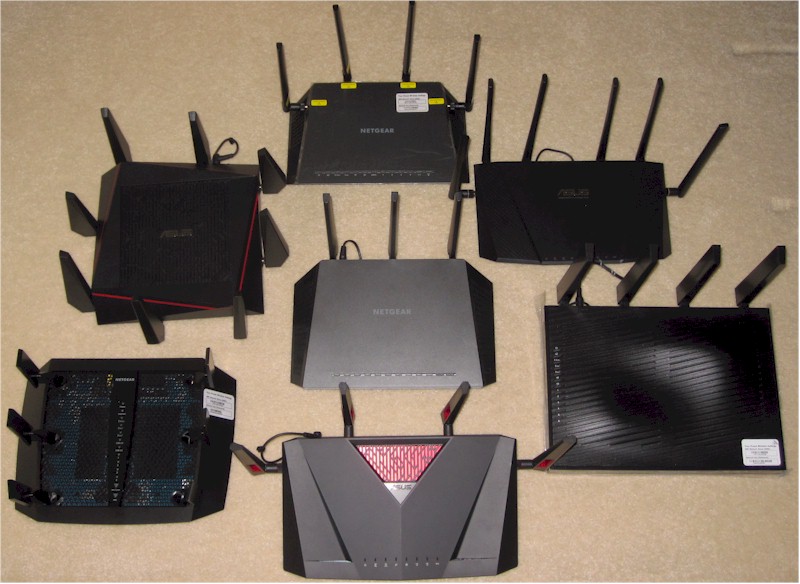
Introduction
The SNB Forums are awash with waaay too much excitement about the new 4×4 Broadcom-based AC3100 and AC5300 class routers. Even folks who paid around $300 not too long ago for AC2350 / 2400 4×4 and AC3200 "tri-band" and suffered through bugs and compatibility problems are lining up to spend up to $500 (!) in hope that this time, they’ll get "the one".
What has particularly caught my eye are claims of significantly improved Wi-Fi performance. This would seem to contradict my advice to stick with AC1900 routers as the best price / performance choice right now. The data in the Router Charts for AC2350, AC2600, AC3200 and AC5300 class routers back my advice. But my RF chamber based testing isn’t the same as open-air testing, so maybe I’m missing something. So it was time to get out of the chamber and into the air for some real world results.
Tri-band and MU-MIMO don’t improve range
Neither "tri-band" / Smart Connect nor MU-MIMO contain technology designed to extend range. Both are primarily designed to improve total bandwidth use.
MU-MIMO routers requires MU-MIMO devices and only improve throughput for 5 GHz downlink (router to device) and strong signals. You need at least two MU devices to see any benefit and you get the optimum throughput gain with 3 MU devices.
"Tri-band" (actually tri-radio) routers work with all devices and work up and downlink. They use two 5 GHz radios so slower devices can be directed to one radio, faster devices to the other. "Smart Connect" technology is supposed to automatically direct devices to the proper radio. But many devices don’t like being told what to do and stubbornly stay on a radio, slowing down faster devices.
The Method
I used the same open-air test process used in Does An AC Router Improve N Device Performance? This time I used two test clients; an N600 class notebook and AC580 class smartphone.![]()
The N600 test client was an Acer Aspire S7 Ultrabook running Windows 8 with an Intel Dual Band Wireless N 7260 Plus Bluetooth adapter with 16.5.3.6 Win 8 64 bit driver. This 2×2 N600 class adapter is found in many notebooks and has the advantage of not providing a performance edge to any router because Intel isn’t used in consumer routers. 2×2 adapters in general, either single or dual-band, are also commonly included in many notebooks.
The 1×1 AC580 device was a Moto X XT1094 2nd generation smartphone. I don’t know the maker of the radio device.
Since the question this time is whether it makes sense to trade up from an AC1900 router, I used the top-ranked NETGEAR R7000 Nighthawk as the baseline reference. To keep testing manageable, I ran up and downlink open air tests in only one location, with each router in my downstairs corner office and the client in test Location D.
The diagram below shows Location D on the upper level of an approximately 3300 square foot two-level home, approximately 35 feet away (direct path) from the router. There is one wood floor, one lower level sheetrock wall and a sheetrock ceiling between router and Client.
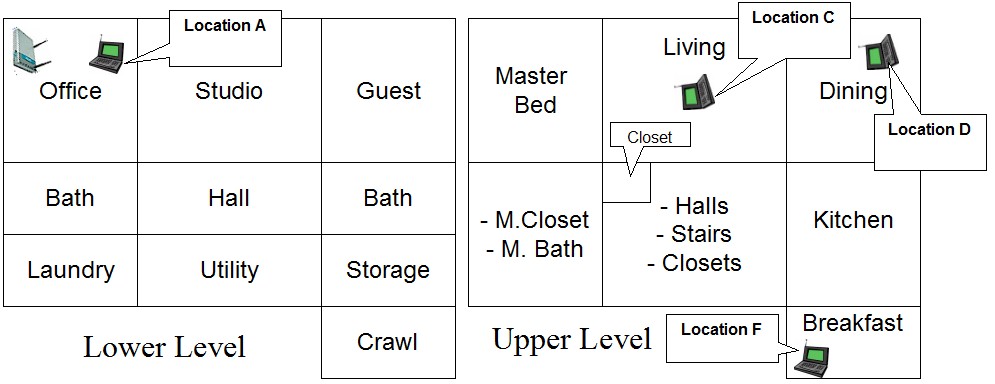
Test Locations
This location was chosen because it represents a mid-signal "transition" location for 2.4 GHz and the furthest operable 5 GHz location; precisely the kind of location where you would want to see a performance improvement from buying a new router.
Each IxChariot throughput script using a single TCP/IP stream was run once for 90 seconds. If the results were particularly low or unstable, the test was repeated. There were no other networks active during testing. As is our standard practice, WPA2/AES encryption was used for all testing with channel 6 and 20 MHz mode used in 2.4 GHz and channel 153 and Auto mode used in 5 GHz.
The routers tested are listed in Table 1. All were loaded with latest firmware before testing. All the processors are dual-core. I originally was going to test only the newer Broadcom-based 4×4 routers and the new MU-MIMO enabled NETGEAR R7500v2. But I decided to include the previous-generation 3×3 "tri-band" AC3200 class routers, because I have seen so many people itching to trade up from them.
| Router | Firmware | Class | Processor | Price |
|---|---|---|---|---|
| NETGEAR R7000 (reference) | 1.0.5.48_1.1.79 | AC1900 | Broadcom BCM4709 @ 1 GHz | $187 |
| ASUS RT-AC3200 | 3.0.0.4.378_7838 | AC3200 | Broadcom BCM4709 @ 1 GHz | $259 |
| ASUS RT-AC5300 | 3.0.0.4.380_838 | AC5300 | Broadcom BCM47094 @ 1.4 GHz | $495 |
| ASUS RT-AC88U | 3.0.0.4.378_8596 | AC3100 | Broadcom BCM47094 @ 1.4 GHz | $280 |
| NETGEAR R8000 | V1.0.2.46_1.0.97 | AC3200 | Broadcom BCM4709 @ 1.4 GHz | $270 |
| NETGEAR R8500 | V1.0.0.56_1.0.28 | AC5300 | Broadcom BCM47094 @ 1.4 GHz | $355 |
| NETGEAR R7500v2 | V1.0.0.28 | AC2350 | QCA IPQ8064 @ 1.4 GHz | $198 |
Table 1: Routers and firmware
Neither link rate nor RSSI was monitored during testing, because both are only indirect indications of performance and vary greatly from device to device. Telling you an RSSI of -60 dBm was measured means little because your environment (router, device, physical environment, RF environment) is different than mine. In the end, it’s delivered throughput that matters, so that’s what was measured.
The Results – N600 Client
The percentage difference between the throughput measured using the NETGEAR R7000 reference router and the router under test was calculated. Results were then plotted for each band and traffic direction. If you want to do the math, the reference throughput measurements were: 2.4 GHz dn – 22.6 Mbps; 2.4 GHz up – 53.9 Mbps; 5 GHz dn – 73.1 Mbps; 5 GHz up – 43.4 Mbps.
2.4 GHz downlink results are the best of the four test runs, with all routers producing higher throughput. Note that trading up from both ASUS’ RT-AC3200 and NETGEAR’s R8000 AC3200 class routers resulted in higher throughput. (56% higher for the ASUS; 78% higher for the NETGEAR).
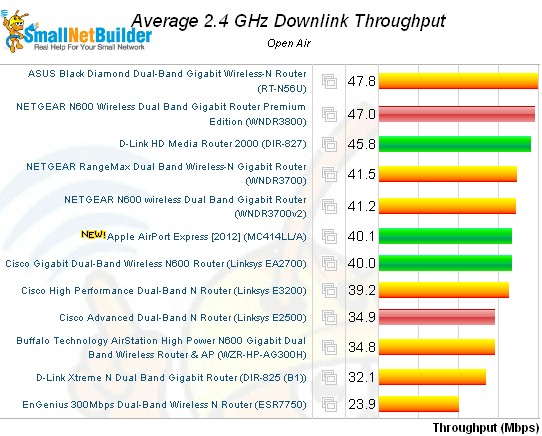
2.4 GHz Downlink Throughput Change – N600 client
2.4 GHz uplink results also showed many gains, but also the first losses. The only NETGEAR router to produce higher 2.4 GHz uplink throughput was the AC5300 class R8500 Nighthawk X8.
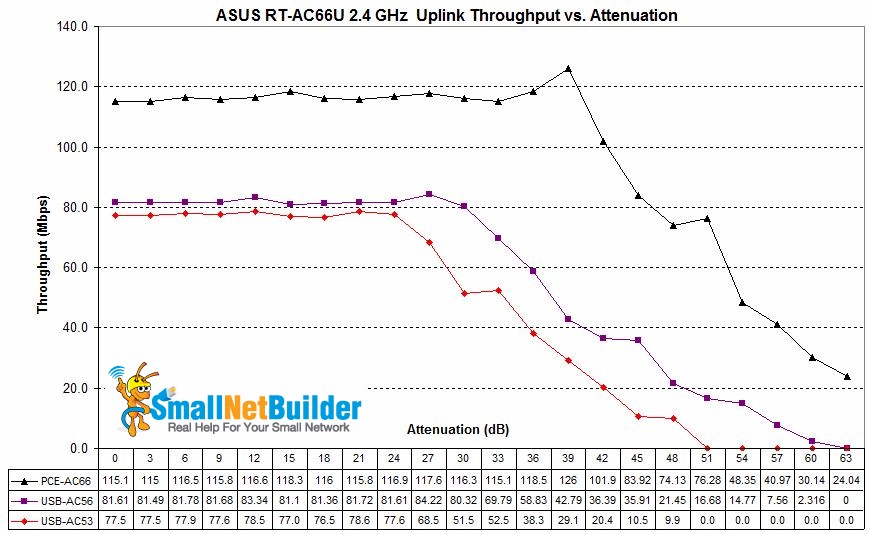
2.4 GHz Uplink Throughput Change – N600 client
As you might expect, 5 GHz downlink results were quite different. For AC3200 and AC5300 routers, I ran two sets of tests; one with the standard Channel 153, the other with Channel 44. The reason was that "tri-band" routers use internal antennas for one of the 5 GHz radios. Since the NETGEAR 8500’s amplified antennas connect to the "low band" 5 GHz radio, I thought it would be good to see what difference they made compared to the non-amplified antennas on ASUS’ RT-AC5300 and the two AC3200 class routers.
Turns out it’s good I ran the Channel 44 tests, since they were the only ones showing throughput gains. The NETGEAR R8500 showed the most change, moving from a 23% throughput loss using the internal non-amplified antennas on Channel 153 to a 72% (!) gain with the external amplified antennas on Channel 44. Note that both low and high 5 GHz bands can use the same maximum transmit power levels since an FCC rule change in 2014. All routers in this test are designed to take advantage of that change.

5 GHz Downlink Throughput Change – N600 client
5 GHz uplink results are even more dismal; merely an 8% gain for only one product, ASUS’ $500 RT-AC5300.
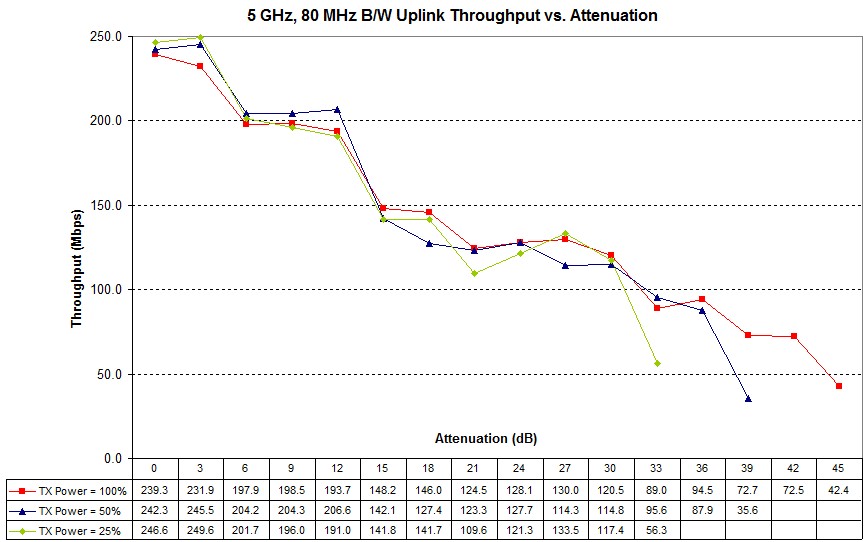
5 GHz Uplink Throughput Change – N600 client
The Results – AC580 Client
The tests with a smartphone client provide another look at the potential benefits that throwing up to almost half a grand at your Wi-Fi problems might bring. Smartphones not only have lower class 1×1 radios, but also generally poorer Wi-Fi performance, given all the other radios and antennas that have to be crammed into them.
The reference throughput measurements from the NETGEAR R7000 this time were: 2.4 GHz dn – 30.1 Mbps; 2.4 GHz up – 12.3 Mbps; 5 GHz dn – 56 Mbps; 5 GHz up – 18.5 Mbps.
The 2.4 GHz downlink tests show the worst performer was ASUS’ AC3100 class RT-AC88U, with 55% lower throughput. NETGEAR’s AC2350 class R7500v2 was next worst (or best), moving into the gain side with 11% throughput improvement. The best performer this time was NETGEAR’s R8500. So maybe those amplified antennas do help! ASUS’s AC5300 class router isn’t far behind, though, with its plain ol’ standard antennas.
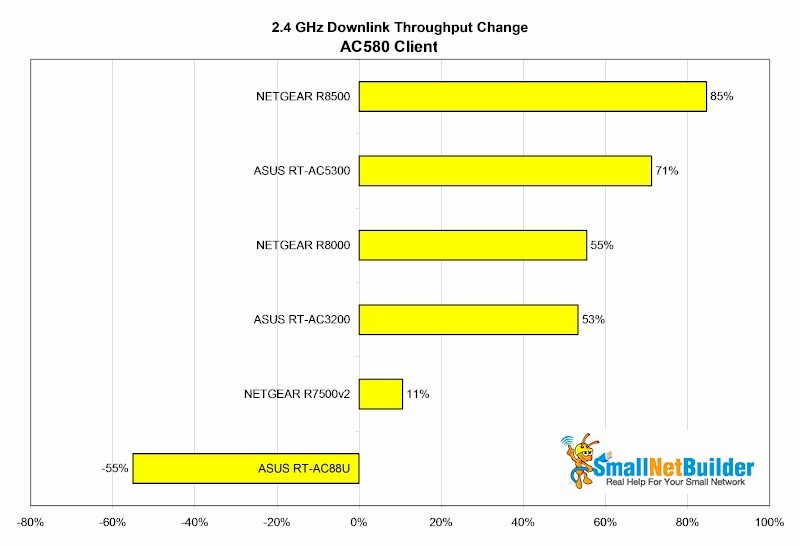
2.4 GHz Downlink Throughput Change – AC580 Client
2.4 GHz uplink results have the NETGEAR and ASUS again in the #1 and #2 spots, but with the NETGEAR widening the lead with 134% gain vs. the ASUS’ 96%. Worst performers again were the two dual-radio 4×4 routers.
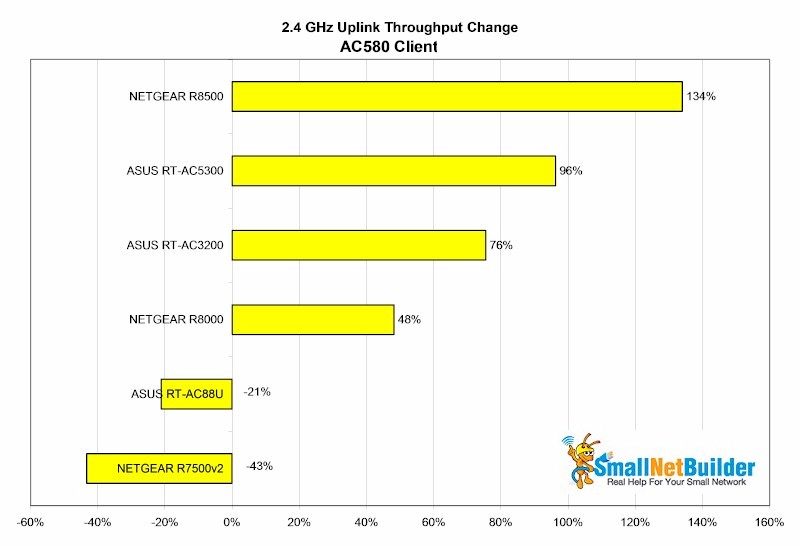
2.4 GHz Uplink Throughput Change – AC580 Client
The 5 GHz downlink again show an almost equal number of losers and gainers. The largest gain came from ASUS’ RT-AC3200 using Channel 44. The two AC5300 class routers ended up with only modest gains, both using Channel 44.
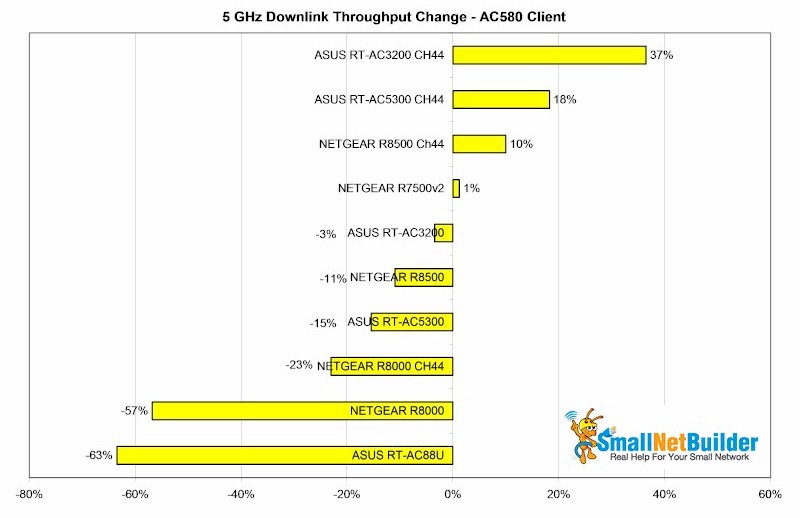
5 GHz Downlink Throughput Change – AC580 Client
5 GHz uplink produced the largest difference between the ASUS and NETGEAR AC5300 routers, with the ASUS producing a 31% throughput gain and the NETGEAR a 22% loss using the Channel 44 results. The Channel 153 results still put the ASUS ahead of the NETGEAR with losses of 21% and 33%, respectively.
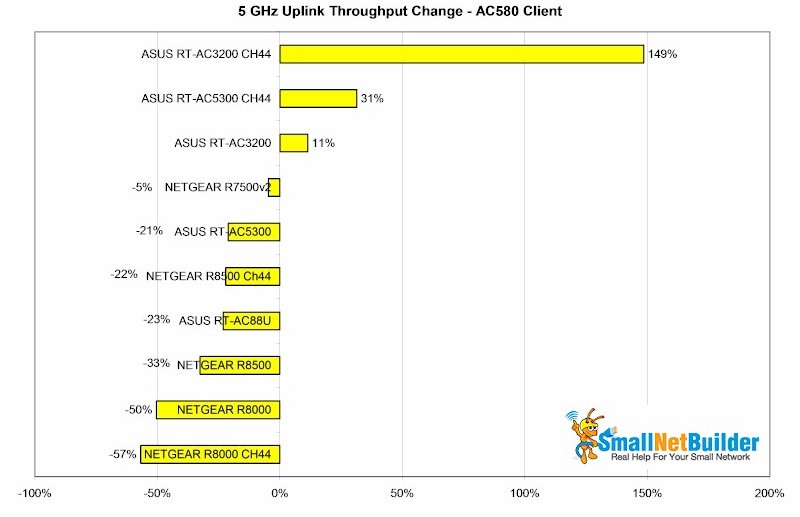
5 GHz Uplink Throughput Change – AC580 Client
Summary Plots
That’s a lot of data to absorb. So let’s look at two summary plots. This is the same data, just presented in a different way. Both plots sum the four throughput changes and sort the products based on the totals. Once again, AC3200 and AC5300 "tri-band" routers have two sets of results.
The first plot shows results for the N600 client. It’s clear that there are generally more gains in 2.4 GHz than 5 GHz. In fact, no product produces significant throughput gain in both bands. The best of the bunch is the ASUS RT-AC5300, which produces throughput gain in all cases except perhaps where it most counts: 5 GHz downlink. Its competition, NETGEAR’s R8500, comes in third or second (the ASUS RT-AC5300 Channel 44 results are in the #2 slot), but only with its amplified antennas using Channel 44. The R8500 drops into seventh place using Channel 153 results.
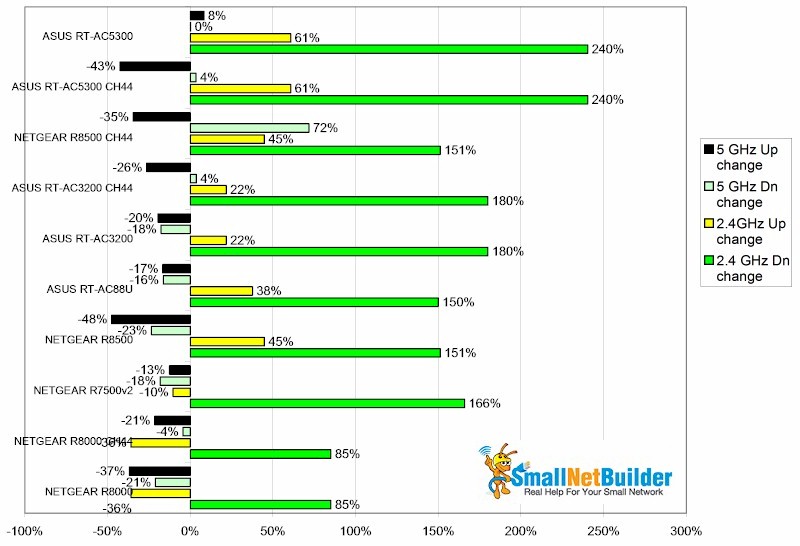
Throughput Change Summary – N600 client
Using the 1×1 AC850 smartphone client produces very different results. The top slot goes to ASUS’ RT-AC3200, which produced the highest 5 GHz gains of 37% dowlink and 149% uplink. The only other router to produce 5 GHz band up and downlink gains was the much more expensive ASUS RT-AC5300.
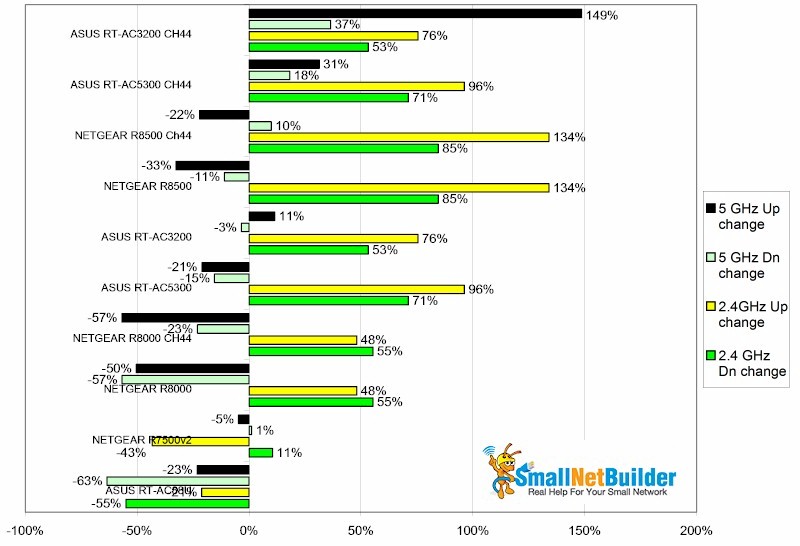
Throughput Change Summary – AC580 client
Closing Thoughts
If you’re looking for significant gains in 5 GHz performance, ain’t none of the newer routers that will likely do much better than the AC1900 router you already own. It looks like they can help squeeze out more 2.4 GHz throughput where you currently get a signal, and maybe turn a marginal location into a more reliable one. But you don’t have to spend $500 for that; older AC3200 routers appear to provide just as good 2.4 GHz throughput gains. AC3200’s also are a lot cheaper and have the benefit of over a year out in the wild. This should give them the advantage of being more stable via bugfix firmware updates.
AC3200’s can also help in the 5 GHz band, but not with higher throughput per se; the data shows that’s unlikely. Instead, two 5 GHz radios help prevent bandwidth wasted by slower devices competing for time on a single radio. By letting your faster devices actually run faster, airtime will be used more efficiently, more bandwidth will be freed up and your Wi-Fi network should run more smoothly.
But "tri-band" routers aren’t a slam dunk. The Smart Connect feature that is supposed to automatically assign clients to radios is implemented very differently from router to router. And even when it’s done well, some devices will just refuse to cooperate and constantly disconnect or insist on connecting to the "wrong" radio, reducing throughput for the devices that are properly assigned. Fortunately, Smart Connect can be disabled and clients manually assigned to a radio. But that’s more work and requires your family members cooperate and use only the proper SSID for each device.
If you want to give AC3200 a shot, I’d recommend trying TP-LINK’s Archer C3200. Its flavor of Smart Connect steers clients between 2.4 and 5 GHz (not all Smart Connect routers do) and produced the most consistent total throughput improvement of any tri-band router we’ve tested yet. And it’s a hell of a lot cheaper than the latest Wi-Fi science experiments that we now know aren’t going to work the miracles you’re looking for!
